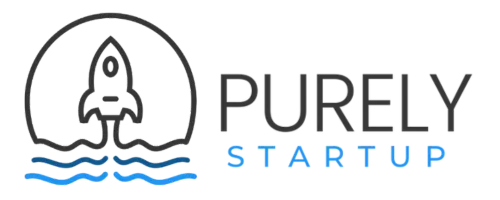
Construction Recruitment (Guide): Everything You Need to Know
Skilled labor is hard to find and harder to keep. In construction, a single bad hire can delay projects, increase costs, or lead to safety issues. That’s why the hiring process must be both efficient and thorough. This construction recruitment guide is here to make the process smoother.
We'll share practical tools, useful tips, and strategies that help you hire smarter and faster. Whether you’re recruiting for a growing firm or managing a few key hires a year, this construction recruitment guide will walk you through tools, practical tips, and recruiting strategies that connect you to real talent.
Let’s first discuss what construction recruitment is.
Construction Recruitment (Guide): Everything You Need to Know
What Is Construction Recruitment?
Why Construction Recruitment Matters
The Construction Recruitment Process: Key Hiring Steps
Best Tools for Construction Recruitment
3. Project Management Platforms
4. Applicant Tracking Systems (ATS)
Best Recruitment Strategies That Work in Construction
2. Go Where the Talent Hangs Out
Challenges in Construction Recruitment
How to Speed Up the Hiring Process Without Losing Quality
What Is Construction Recruitment?
Construction recruitment means sourcing and hiring teams for building projects, from site supervisors and estimators to project managers and safety officers.
It’s not enough to list a job; you need to define what real-world duties involve, including schedule control, vendor coordination, budget tracking, and managing chaos when suppliers fail to appear. Successful construction recruitment combines clear role definitions, outreach where talent gathers, and hands-on assessment of soft and hard skills.
You want people who can work with drawings, adapt under pressure, and lead crews safely. That’s what professional construction recruitment looks like: it finds workers who not only fit but also drive value.
Related Article: How to Recruit Top Talent in Construction Management: 7-Step Guide
Why Construction Recruitment Matters
Hiring right isn’t optional. According to McKinsey, 98% of megaprojects exceed cost estimates by 30%, 77% are at least 40% late. Often, the problem comes down to leadership and staffing errors. Construction recruitment plays a key role in preventing these failures.
Hiring someone who understands site software, planning, and safety is a necessity. Poor hires slow projects, inflate costs, and harm your reputation.
The difference between strong recruitment and random hiring can be millions saved or lost and deadlines met or missed. Skilled construction recruitment helps you build a reliable, capable, and motivated workforce that gets results.
The Construction Recruitment Process: Key Hiring Steps
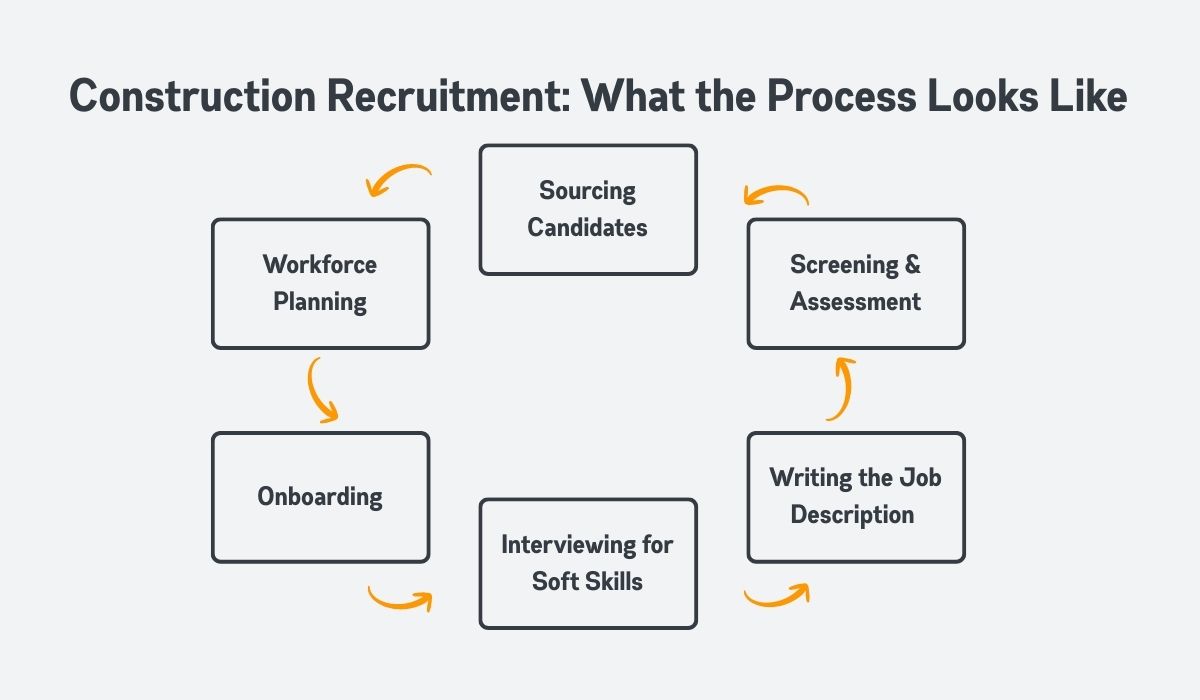
Let’s break down the hiring process for construction into key stages.
Workforce Planning: Start by identifying the number and type of roles you need to fill. Consider your project timelines, budgets, and current team structure.
Writing the Job Description: Avoid vague, cookie-cutter ads. Specify tools, certifications, and daily responsibilities. This helps filter out underqualified candidates.
Sourcing Candidates: Use a mix of channels; job boards, trade schools, referrals, and agencies to create a diverse pool of applicants.
Screening and Assessment: Evaluate resumes for required experience and certifications, then use interviews and technical tests to assess job readiness.
Interviewing for Soft Skills: In addition to experience, assess communication, leadership, and adaptability. This ensures cultural and operational fit.
Onboarding: Once hired, integrate your new team members through safety orientations, tool training, and clear task assignments.
Best Tools for Construction Recruitment
Before we dive into strategy, let’s talk about tools. You wouldn't build a house without a blueprint, right? The same applies to hiring. Using the right platforms and software can save you from weeks of delays and piles of bad resumes.
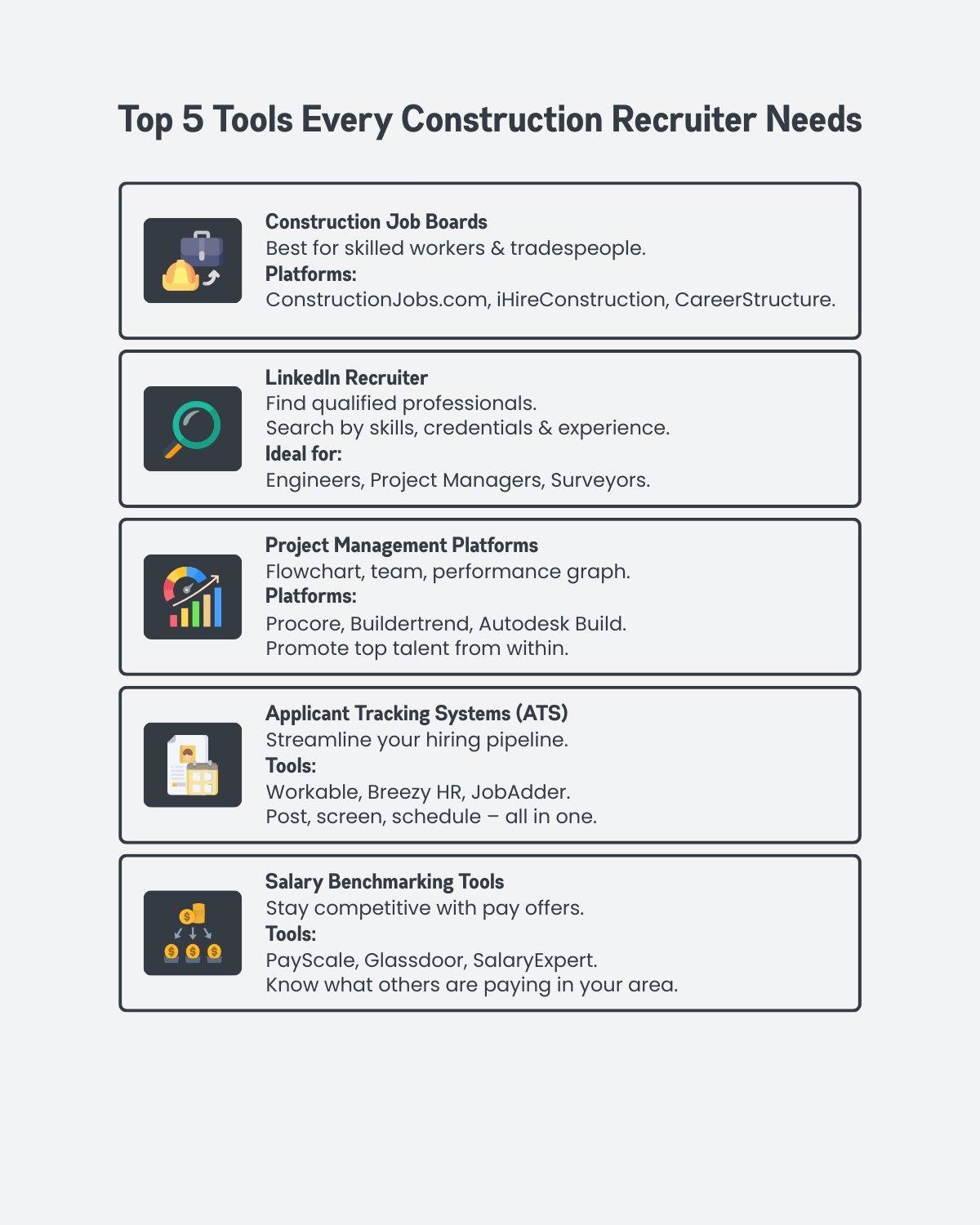
1. Construction Job Boards
General job boards get general results. But platforms like ConstructionJobs.com, iHireConstruction, and CareerStructure are tailored for the industry. They attract candidates who already understand the demands of construction, from safety protocols to on-site experience.
2. LinkedIn Recruiter
For roles that require specific experience or qualifications, engineers, quantity surveyors, or project managers, LinkedIn Recruiter offers advanced filters to find the right profiles.
You can search by credentials, industry experience, and location. This makes it easier to target professionals who meet your exact job requirements.
3. Project Management Platforms
Tools like Procore, Buildertrend, and Autodesk Build aren’t only for managing projects only they can also assist in internal hiring. These platforms allow you to track team performance, communication, and task completion. This makes it easier to identify reliable workers or promote top talent from within your own crew.
4. Applicant Tracking Systems (ATS)
Are you still sorting resumes manually? Tools like Workable, Breezy HR, and JobAdder let you post jobs, screen applicants, schedule interviews, and manage your hiring pipeline, all in one place. ATS platforms save time and reduce hiring mistakes by keeping everything organized and visible.
5. Salary Benchmarking Tools
Platforms like Glassdoor for Employers, PayScale, and SalaryExpert help you offer competitive pay. They provide insights into what others are paying for similar roles in your area. That’s key to making attractive offers and staying ahead in a competitive labor market.
Best Recruitment Strategies That Work in Construction
Not every hiring strategy is effective for construction. You need an approach grounded in the field, mud, sweat, and spreadsheets.
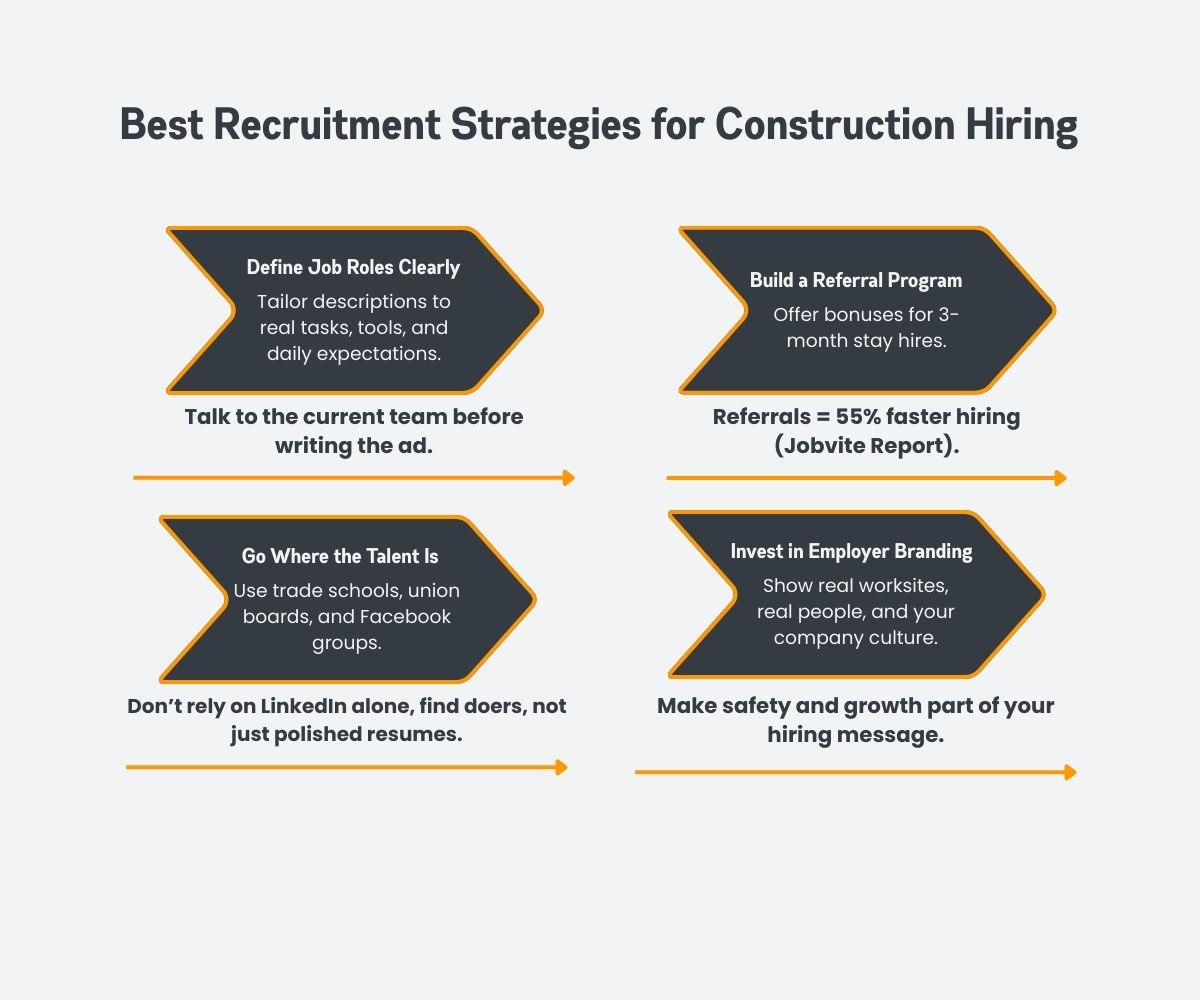
1. Define Job Roles Clearly
Don't copy-paste generic job descriptions. Instead, talk to your current team. What does a day look like for a junior site engineer? What tools do they use? Then, add these details to the job ad. This filters out unqualified applicants early and attracts those who know the ropes.
2. Go Where the Talent Hangs Out
Posting on LinkedIn is great; however, tradespeople and junior staff often look elsewhere. Try local trade schools, union boards, and construction Facebook groups. You’ll find real doers rather than resume-polishers.
3. Build a Referral System
Your current employees know who works hard in the field. Offer bonuses for referrals that stay 3+ months. According to a report by Jobvite, candidates referred by current employees are hired 55% more quickly than those who apply through traditional job boards or career websites.
4. Focus on Employer Branding
Would you work for your company if you read your job ad? If not, change it. Start showing real photos of your worksites, share what makes your crew special, and highlight how you invest in safety and growth. This will help a lot, as people want to work where they feel seen and safe.
Related Article: 11 Recruitment Strategies for Construction Companies to Attract and Keep the Best Talent
Challenges in Construction Recruitment
Recruiting in the construction industry means finding qualified people who can work safely, meet deadlines, and handle real-world stress. But that’s easier said than done. The following are some of the biggest roadblocks that slow down or derail the recruitment process.
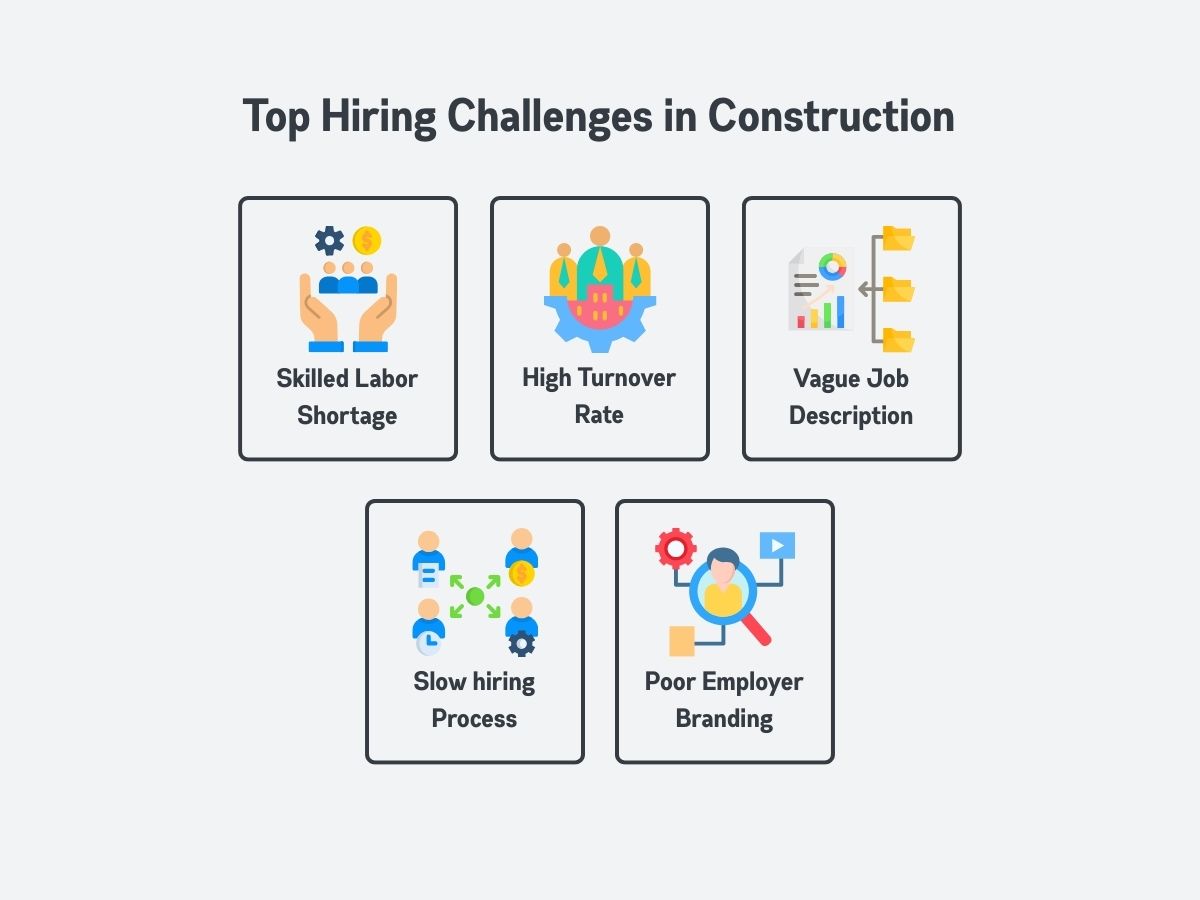
1. Skilled Labor Shortage
One of the biggest challenges in construction recruitment is the shrinking pool of skilled workers. As older workers retire, fewer young people are entering the trades. This leaves a talent gap that’s hard to fill, mainly for roles like welders, crane operators, and site supervisors.
2. High Turnover Rates
In construction, people often leave jobs quickly. Maybe for better pay, an easier role, or just because the work is tough. This means companies are always hiring and spending time and money training new people. It’s hard to grow a strong team when workers keep changing.
Plus, high turnover can hurt team morale and project speed.
3. Vague Job Descriptions
Job ads that don’t clearly explain the work scare off great candidates. When posts are too general, they attract the wrong people or confuse skilled workers.
A good job post should include clear duties, required skills, and licenses. Without that, recruiters end up sorting through tons of resumes and still might not find the right candidate.
4. Slow Hiring Process
If hiring takes too long, good candidates will move on. Long waits between interviews or unclear communication can frustrate job seekers.
In a fast-paced market like construction, speed matters. A slow process not only causes you to miss top talent but also gives a poor impression of your company’s efficiency and work culture.
5. Poor Employer Branding
Many construction firms don’t show why they’re a great place to work. Without sharing company values, team culture, or success stories, they struggle to stand out.
Candidates today want more than simply a paycheck; they want purpose and a positive work vibe. If your brand doesn’t speak to them, they’ll apply somewhere else.
How to Speed Up the Hiring Process Without Losing Quality
Use Pre-Screening Tools: Platforms like Workable or Breezy HR allow automated pre-screening questions. This helps you weed out unqualified applicants instantly.
Conduct Video Interviews: When hiring remote workers or shortlisting candidates, use video interviews to save time while still assessing soft skills.
Involve Site Managers in Hiring: Don’t keep hiring decisions limited to HR. Let field managers interview candidates to check technical knowledge and culture fit.
When to Use a Construction Recruitment Agency
Some companies, especially startups or those scaling fast, can’t handle hiring in-house.
That’s where recruitment agencies come in. If you're unsure how to recruit top talent in construction management on your own, you can hire agencies like Purely Startup, which specialize in construction talent.
These agencies pre-screen candidates, saving you from sorting unqualified resumes. They also know how to match personality to job role; a site manager who fits your company culture is gold.
Outsourcing isn’t lazy; it’s strategic, especially when timelines are tight or when hiring for niche roles like BIM engineers or LEED-certified professionals.
Final Word from Purely Startup
Great teams don’t happen by luck; they’re built, just like your projects. Construction recruitment works best when you treat it like part of the job: plan smart, use the right tools, and stay consistent.
No matter if you’re using job boards, LinkedIn, or tracking team performance on-site, each step helps you hire with purpose.
Don’t settle for resumes that “might” fit; go for people who can do the work in actuality.
Remember, even one great hire can lift an entire crew. So slow down, choose wisely, and build your workforce like you build your sites: strong, skilled, and ready to last!
